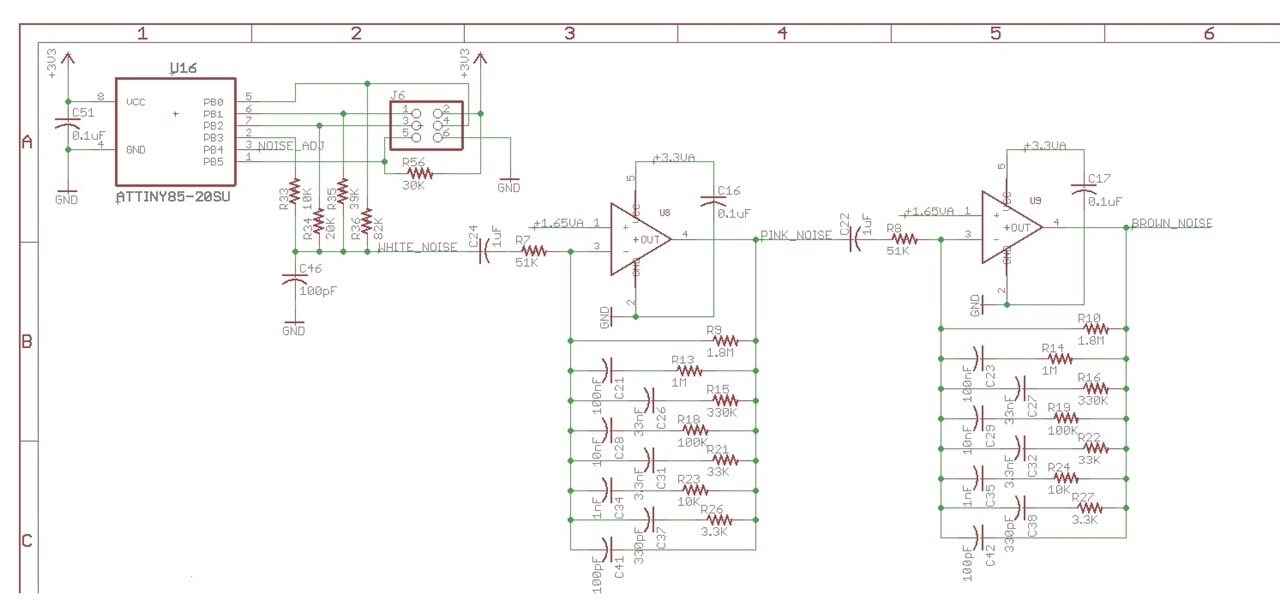In my prior Op-Amp-a-Palooza posts (/challenges-projects/project14/opampapalooza/b/blog/posts/adding-additional-capabilities-to-my-korg-volca-modular-synthesizer-and-learning-about-op-amps-at-the-same-time) and (/challenges-projects/project14/opampapalooza/b/blog/posts/adding-additional-capabilities-to-my-korg-volca-modular-synthesizer-and-learning-about-op-amps-at-the-same-time-part-2---power-supply-bring-up-and-analyzing-the-noise-source) I described, at a high level, my design and the intent of my project and tested my noise generator circuit. Today I will cover the filtering of the basic white noise into pink and brown noise sources.
Prior to jumping into the noise, I though I would quickly bring you up to date on on the status of my project. All of my parts have finally arrived and I have completed the assembly of the board. With a completed board, I started working on the firmware for the project (Yes, even a good Op-amp project needs firmware) and a control panel program to send commands to firmware to assist in debugging. Here is an image of the completed PCB:

The wires at the bottom of the image were added to assist in debugging the board. The twisted pair of wires (bottom left) are attached to the I2C bus on the boards, allowing be to view the commands being sent to various components (DACs, EEPROM and the Digitial Potentiometer). The two other wires are the white noise generator output (bottom center) and the analog signal sent to the noise generator to set the number of bits summed to form the white noise output. The other wires (short jumper at the bottom edge of the board, near the center and the two wires (upper right area) were added to fix a couple of schematic/layout issues (write enable for the EEPROM and I2C bus connections to the digital potentiometer to control the noise output level). Another major issue found in the debug phase, was a gain issue on the noise filters, which was causing the filters to saturated except for zero crossing of the input signal. All of the these fixes will be reflected back into the schematic and layout at the end of my entry.
At this point I have tested almost all of the hardware, with the exception of the EEPROM. The data presented here covers the ATtiny noise source, both noise filters, noise selector mux, digital potentiometer (attenuator), noise buffer and the DAC providing the noise source command for number of bit used in the summing of the noise output.
Noise Filtering
Here is the updated schematic fragment of the noise filters (White -> Pink -> Brown):

So, now we can take a look at the noise filters. First lets take a look at the White, Pink and Brown noise sources, while the noise generator is commanded to a single bit noise signal:


The first image show the White and Pink noise signals. The Pink signal is 180° out of phase from the input, as the filter is built around an inverting amplifier circuit. The second image shows the White and Brown noise signals. The Brown signal is in phase with the input, due to two inversions, and can be seen rising and falling slightly with the peaks in the input waveform. To get a better appreciation of the effects of these filters we will look at the resulting spectrum captures:


The spectrum views were captured between DC and 20kHz. In both images the input signal is virtually flat out to 20kHz. In the first image, the Pink spectrum is down ~10dB at 2kHz ans ~18dB at 20kHz. The second image, the Brown spectrum is down ~20dB at 2kHz and ~36db at 20kHz, or very close to twice the attenuation of the Pink spectrum.
Now lets take a look at the White, Pink and Brown noise sources, while the noise generator is commanded to a 2 bit noise signal:


The results are very similar to the 1-bit white noise. Here resulting spectrum captures:


Again, the spectrum captures are very similar to the 1-bit white noise source. In the first trace the white noise spectrum show a slight drop on the White noise levels from 10kHz to 20kHz (strange not in both captures). With the spectrum captures not showing much effect in the changing of the number of bits used in summing of the White noise signal, I will skip over the waveforms and move on.
Well, the all of this noise about noise, we might as well hear what this noise sounds like. To that end, I have a couple of videos showing the noise source in action:
I am getting close to having the project complete, but completion date is fast approaching. I will be jumping into to write the MIDI player portion tomorrow and trying to wrap it up by the deadline.
Thanks for reading along and Keep on the lookout for further updates.
